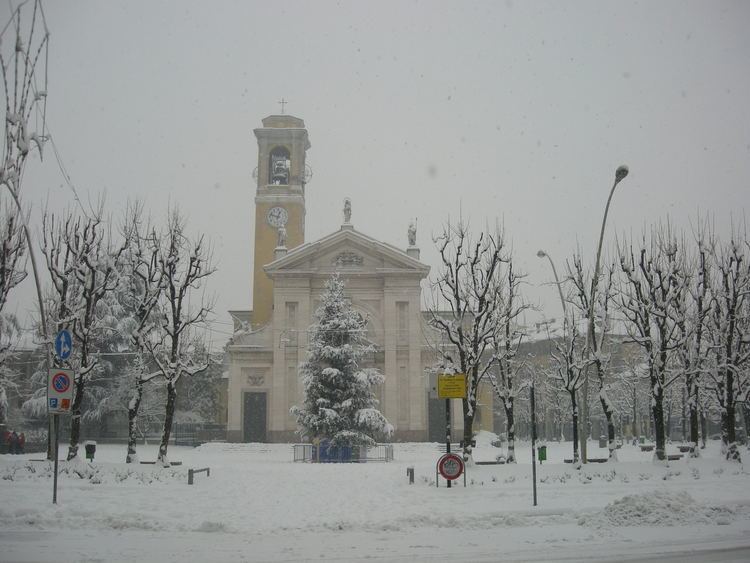Elevation 184 m (604 ft) Time zone CET (UTC+1) Local time Wednesday 2:57 PM Dialling code 0331 (Busto Arsizio Code) | Demonym(s) Parabiaghesi Area 14.16 km² Postal code 20015 | |
 | ||
Dialing code 0331 (Busto Arsizio Code) Weather 14°C, Wind E at 16 km/h, 77% Humidity Points of interest Canale Villoresi, Parco dei mulini, Ecomuseo del paesaggi | ||
Parabiago is a town located in the north-western part of the City of Milan, Italy.
Contents
- Map of Parabiago Metropolitan City of Milan Italy
- Ancient history and Middle Ages
- Modern Age
- 20th century
- Transport
- International relations
- References
Map of Parabiago, Metropolitan City of Milan, Italy
The town is crossed by the road to Sempione (S.S.33) and Milan – Gallarate Railway; nearby flow the Olona river and the Canale Villoresi.
Its demonym in Italian is parabiaghese in the masculine and feminine singular and parabiaghesi in the plural. In the local Insubric dialect it is parabiaghës or parabiagœs in the masculine singular, parabiaghësa or parabiagœsa in the feminine singular, and parabiaghës or parabiagœs in the plural for both genders.
Ancient history and Middle Ages
Parabiago has ancient origins: starting from the first celtic-insubrian settlement (4th century B.C.), it developed during the Roman Empire rule, as documented by various archaeological discoveries of little objects, as the famous Parabiago Patera, a wonderful silver plate probably used to cover an ashes urn.
In the Early Middle Ages, Parabiago was the centre of a parish (pieve) and of an autonomous county, named Comitatus Parabiagi and sometimes Burgaria, governed by the Sanbonifacio family, of frank descent, coming from Verona; in the 7th century, its importance took the lombard Queen Theodelinda, to give permission for a little artificial stream, named Riale or Röngia, which took water from the Olona river and travelled through the village: that stream lasted until the 1928, when it was definitively stilted up.
During the Late Middle Ages, the town was the set of some lombardian events. The Truce of Parabiago (28 – 29 August 1257) led to the Pace di Sant'Ambrogio (Saint Ambrose's Peace), so called because it was signed in the homonymous Basilica in Milan). It put an end to the risk of a civil war between nobles and people in the Commune of Milan.
On 21 February 1339, occurred the Battle of Parabiago between Lodrisio Visconti, with his army named Compagnia di San Giorgio (Saint George's Company), and Luchino Visconti with his nephew Azzone, for the dominion over the Duchy of Milan; the battle was won by the Milanese regular army; according to tradition, this happened thanks to the miraculous apparition of Saint Ambrose. During this time, the Crivelli family inherited from the Sanbonifacio family the County of Parabiago, perhaps still corresponding with the Burgaria County.
In the following centuries Parabiago had a slow decline; it suffered two pillages, in 1449 by Francesco Sforza and in 1527 by Bourbons of Spain, as well as two epidemics (1529 and 1540).
Modern Age
During Spanish rule in Duchy of Milan, the Marquis Camillo Castelli bought the Fief of Parabiago for 8800 lire (26 September 1658); the family extinguished in 1783, with the death of Cardinal Giuseppe Castelli.
Parabiago developed in the 18th century, during the Austrian rule. In this century was born an important international artist, Giuseppe Maggiolini, well known as Maestro d'Intarsio (carver master); in fact he was a great furniture-maker and the first neoclassical cabinet-maker in Europe. In the same period was established the Cavalleri College, a famous school for Milanese noble youths, founded by Father Claudio Cavalleri and his brother Filippo. Between 18th and 19th centuries, the parabiaghese doctor Giuseppe Giannini wrote medical essays beside practising medicine.
Between the 19th and 20th centuries the Industrial Revolution reached Parabiago. The most active industrialists were Felice Gajo, who established the Unione Manifatture di Parabiago (United Manufacturing of Parabiago) (textiles), and Paolo Castelnuovo, who founded in 1899 the first shoe factory in the town. Since then, Parabiago is known as the Città della Calzatura (Shoes City).
20th century
In the 1960s Parabiago like other cities and towns in Northern Italy experienced an economic boom followed by a demographic one. Industrialization caught on, the little traditional shoemakers established middle and big shoe factories; chemical and mechanical industries were born, and attracted immigration from Southern Italy. On 27 November 27 1985 the town took the title of City.
In the early 1990s the majority of the Town Council, formed by D.C. (Christian Democracy), P.S.I. (Italian Socialist Party) and P.R.I. (Italian Republican Party), was forced to resign by the Tangentopoli scandal about the new urbanistic plan, and some important local politicians were arrested.
Transport
In the district there's one stop of Metro Line S5, even if there's a project of the construction of another stop near the border with Nerviano Bourough. One Regional Railway station operated by Trenord is present in the city. Some Movibus (local bus lines) link the town with other boroughs.
International relations
Parabiago is twinned with:
